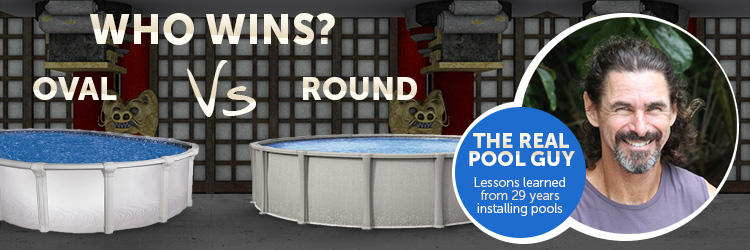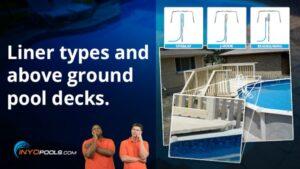It seems to me that when most people first consider getting an above ground swimming pool, they think it is oval. That’s a natural assumption as traditional in-ground pools are oval. After some research, though, most end up getting a round one instead and that’s usually because of the difference in cost. There are some other differences too, so let’s go over them. Shall we?
Why People Want an Oval Above Ground Pool
As I mentioned above, the biggest reason people want an oval above ground is because it looks more like an in-ground. Adding to this is the notion that round pools are synonymous with the cheaper above ground pools. And who wants to look cheap? Despite of the extra cost and effort to have them installed, some will get an oval anyway only for this reason.
People will also decide to get an oval, because of having limited space in their yards. Many homes these days are built on smaller lots that can make getting a pool more challenging. Backyards can be narrow and when you consider any easements or setbacks, there may only be room for an oval that runs parallel with the home. Note: If you want to fit an oval pool in a tight spot, consider the buttress structure. The buttresses of an oval can protrude as much as three feet along the straight sides of the pool. This isn’t as much of an issue lately as most ovals now have what they call a “buttress free” or “yardmore” design which only takes up about a foot of extra space on both long sides.
Michael Phelps Approved?
Not so much. Another big reason why people want an oval above ground is so that they can swim laps in it. This is a big reason as many are looking for ways to exercise more and be healthier. Getting a pool can be expensive and money is tight for most, so justifying this major purchase often includes the exercise that can occur. Though, more often than not, the laps never happen.
Doing laps in a residential pool is a great idea, but is one that rarely occurs in the real world. There are many great ways to use a pool for exercise and many people will get in better shape and feel and look better by having one, but it won’t be from swimming laps. Sorry to be negative, but this is an accurate observation of nearly 30 years so try not to drown the messenger.
There are a select few that actually will swim some form of laps in their above ground. So, if you are planning on proving me wrong by being one of them, make sure to get an oval that is at least thirty feet long. That’ll help set you up for success.
The last reason people opt for an oval above ground is water volleyball. An oval is set up perfectly for volleyball as both ends are usually shallow and net poles can attach nicely to the narrow sides of the pool. Volleyball can be set up nicely in a round pool too, but it’s not as fitting as with an oval.
Why People Get a Round Pool
Homeowners decide on round pools mainly due to cost. A round pool that is sized to hold the same amount of water and have the same area than a similar oval can cost  between a quarter to half of the price. It’s not uncommon to pay about a thousand dollars less for a higher-end 18’ round above ground versus the same model 12’x24’ oval which has the exact same area. That’s quite a saving for something that is exactly the same except for its shape.
between a quarter to half of the price. It’s not uncommon to pay about a thousand dollars less for a higher-end 18’ round above ground versus the same model 12’x24’ oval which has the exact same area. That’s quite a saving for something that is exactly the same except for its shape.
The cost to install a round pool is also considerably less than it is with an oval. Due to its shape, a round pool can distribute the heavy weight of the water easier and therefore doesn’t need that buttress system that is difficult to assemble. To have a pool guy like me install a round pool can cost about half as much as it would for a similar sized oval. Add the round pool purchase savings along with the installation savings and you now have a pretty big number.
You could save a couple of thousand dollars getting a round pool instead of an oval and the absolute only difference will be the pool’s shape. For most that’s hard to deny.
Attention Do-it-yourselfers: Build a Round Pool – Feel Accomplished, Build an Oval Pool – Swear a Lot!
Even though there are fewer do-it-yourselfers these days, many will still install their own above ground. Installing an above ground swimming pool isn’t the most difficult thing to do as a novice, but it’s not easy either. Many who start doing the research for building their own will quickly decide not to tackle an oval and go with the much easier round assembly. This could be the best decision they have made in a while as ovals suck to install. I have a ton of experience, have good experienced help and the right tools for ovals and still prefer not to install them for double the price compared to the same sized round pool. Scared yet? Good. You should be.
Round pools are also more forgiving as they have a greater margin for error than ovals. This means that if you mess up an installation on a round pool it’s not as bad as when you screw up an oval.
So Why the Cost Difference?
I believe in the expression “you get what you pay for”, but sometimes things cost more for different reasons besides quality. That’s the case with oval versus round above ground pools. People will often think that an oval above ground is a stronger design or is made with better materials or will last longer than the less expensive round pool. This is not true. The only reason an oval pool costs more than a round one is because of the oval’s buttress structure.
Unlike a round pool, an oval has straight sides. These straight sides need a structure to keep the wall from pushing out when the pool gets filled with water. That structure is called a buttress system and it has to be heavy-duty and built well. These extra parts are expensive, have to be assembled and aligned and that jack the price way up.
Both shape pools in the same model will have the exact same wall; bottom and top frame; top rails and caps. Because of this, given the same conditions, the more costly oval won’t last one day longer than a similar round model. Just so you know.












Leave a Reply